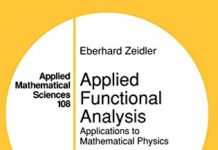
Ebook Info
- Published: 2011
- Number of pages: 1158 pages
- Format: PDF
- File Size: 7.20 MB
- Authors: Eberhard Zeidler
Description
In this third volume of his modern introduction to quantum field theory, Eberhard Zeidler examines the mathematical and physical aspects of gauge theory as a principle tool for describing the four fundamental forces which act in the universe: gravitative, electromagnetic, weak interaction and strong interaction. Volume III concentrates on the classical aspects of gauge theory, describing the four fundamental forces by the curvature of appropriate fiber bundles.This must be supplemented by the crucial, but elusive quantization procedure. The book is arranged in four sections, devoted to realizing the universal principle force equals curvature: Part I: The Euclidean Manifold as a ParadigmPart II: Ariadne’s Thread in Gauge TheoryPart III: Einstein’s Theory of Special RelativityPart IV: Ariadne’s Thread in Cohomology For students of mathematics the book is designed to demonstrate that detailed knowledge of the physical background helps to reveal interesting interrelationships among diverse mathematical topics. Physics students will be exposed to a fairly advanced mathematics, beyond the level covered in the typical physics curriculum. Quantum Field Theory builds a bridge between mathematicians and physicists, based on challenging questions about the fundamental forces in the universe (macrocosmos), and in the world of elementary particles (microcosmos).
User’s Reviews
Editorial Reviews: Review From the reviews:“This book is the third volume of a complete exposition of the important mathematical methods used in modern quantum field theory. It presents the very basic formalism, important results, and the most recent advances emphasizing the applications to gauge theory. … the book’s greatest strength is Zeidler’s zeal to help students understand fundamental mathematics better. I thus find the book extremely useful since it signifies the role of mathematics for the road to reality … .” (Gert Roepstorff, Zentralblatt MATH, Vol. 1228, 2012)“The present book is a good companion to the literature on the subject of the volume title, especially for those already familiar with it. … the book touches upon a large number of subjects on the interface between mathematics and physics, providing a good overview of gauge theory in both fields. It contains lots of background material, many historical remarks, and an extensive bibliography that helps the interested reader to continue his or her more thorough studies elsewhere.” (Walter D. van Suijlekom, Mathematical Reviews, Issue 2012 m) From the Back Cover In this third volume of his modern introduction to quantum field theory, Eberhard Zeidler examines the mathematical and physical aspects of gauge theory as a principle tool for describing the four fundamental forces which act in the universe: gravitative, electromagnetic, weak interaction and strong interaction. Volume III concentrates on the classical aspects of gauge theory, describing the four fundamental forces by the curvature of appropriate fiber bundles.This must be supplemented by the crucial, but elusive quantization procedure. The book is arranged in four sections, devoted to realizing the universal principle force equals curvature: Part I: The Euclidean Manifold as a ParadigmPart II: Ariadne’s Thread in Gauge TheoryPart III: Einstein’s Theory of Special RelativityPart IV: Ariadne’s Thread in Cohomology For students of mathematics the book is designed to demonstrate that detailed knowledge of the physical background helps to reveal interesting interrelationships among diverse mathematical topics. Physics students will be exposed to a fairly advanced mathematics, beyond the level covered in the typical physics curriculum. Quantum Field Theory builds a bridge between mathematicians and physicists, based on challenging questions about the fundamental forces in the universe (macrocosmos), and in the world of elementary particles (microcosmos). About the Author The author is a retired director of the Max Planck Institute for Mathematics in the Sciences, Leipzig (Germany). He is a member of the German National Academy of Sciences, Leopoldina. Read more
Reviews from Amazon users which were colected at the time this book was published on the website:
⭐Regardless of any subjective reasons for liking this book, there is an objective reason for rejecting it and sending it back to the author for revision. The problem lies in the notation used for change of variables. There is a standard notation for it, used by mathematicians and physicists alike. One may look at the wiki entry for “Tensor” for comparison. However, the author uses instead a non-standard one. This would not be a problem if the author’s notation were an improvement, or at least as good as the standard, or even just a little bit worse, but it is not.The problem can be first seen in eqn (0.35), page 24. Here we see what appears to be a distinction being made between two different dummy variables. However, that is not the meaning that the author intends. He means that the sum is invariant under a change of variables from x to x’ = x'(x). In standard notation, the prime would be on the letter v and not on the index alpha. Delta needs to be carefully defined so that we know whether it is the partial with respect to x, or x’. As it is, it appears to be with respect to the alpha prime index on x, but in reality it is something quite different. This is not a typo as we see from the line just below the equation. Here we cannot fix things by removing the prime from the index alpha and placing it on the variable v for in doing so we would end up with three alpha indices on the right hand side of the equation rendering it meaningless. Moving down one more line we see primes on integer indices. One might wonder what 1′, 2′, 3′ and 4′ are meant to be. In fact they are, of course, 1, 2, 3, and 4. However, the notation using primes is forced on the author because without primes on the integers, he would be forced to place a prime on the x’s (where they belong) and then to rewrite the lines above. When we get to chapter 8 where tensor analysis is discussed, the problem with the notation becomes a disaster. For instance, on page 442 in the equation following eqn (8.3), the author has forgotten to place the primes on the condition i = 1, . . . ,n. Ordinarily this would be just another in the mind-numbing array of typos with which the book is marred. But in this case, the placement of primes is crucial for understanding the notation. It gets worse on page 445 in the equation just below eqn (8.5) where the matrix G is defined in two different ways. The placement of primes on the indices is the only way to distinguish these two different matrices. Therefore, it is meaningless to ask what is the entry in the first column, second row of G. We must know whether we are talking about the G with a prime on the lower index, or the G with a prime in the upper index. For this reason, it becomes necessary for the author to place primes on integers as he does repeatedly in expressions like i’ = 1′, . . . , n’ (without ever mentioning that n’ = n) and even i’ = 1′, 2′, 3′.This notation prevents the author from presenting coordinate free equations because the primes are in the coordinates. This becomes apparent on page 496 where he finally has to admit in eqn (8.107) that one of his G matrices is actually the inverse of the other and in the equation just above (8.111) where he is finally forced to place the prime on the script A where it belongs.To add insult to injury, he begins chapter 8 with the quote from Liebniz, “It is worth noting that notation facilitates discovery. This in a most wonderful way, reduces the mind’s labor”. My copy of the book is overloaded with margin notes where I have fixed up the equations. I was able to figure out what the author meant because I have studied tensor analysis in the past. If the reader is reading this material for the first time, I wonder at their ability to understand the book at all and applaud their willingness to burden their minds with such an increase in labor.
⭐This is not a review of the contents of Dr. Zeidler’s book; I simply wish to question Springer-Verlag’s choice of binding for Volume III in this projected series and bring a concern to the attention of prospective buyers.The hardbound editions of Volumes I and II in this series were bound in identical (and attractive) covers and came clearly labeled as Quantum Field Theory I and Quantum Field Theory II on the spines. However, Volume III is bound in an entirely different style, and the identifying label on the spine is printed so differently from Volumes I and II that the third volume does not even appear to be part of the same series. As I said in the title of this review, this is indeed a “cosmetic” concern, but when one is investing several hundred dollars in an ambitious series like this, the least one can expect is continuity and coherence in the binding and cover design.This issue will surely not deter any serious reader from purchasing this unique and ambitious series. However, one cannot detect the difference through online views of the books; I thought that prospective buyers should at least be aware of the problem. I now wonder what the future volumes in this series will look like.
Keywords
Free Download Quantum Field Theory III: Gauge Theory: A Bridge between Mathematicians and Physicists 2011th Edition in PDF format
Quantum Field Theory III: Gauge Theory: A Bridge between Mathematicians and Physicists 2011th Edition PDF Free Download
Download Quantum Field Theory III: Gauge Theory: A Bridge between Mathematicians and Physicists 2011th Edition 2011 PDF Free
Quantum Field Theory III: Gauge Theory: A Bridge between Mathematicians and Physicists 2011th Edition 2011 PDF Free Download
Download Quantum Field Theory III: Gauge Theory: A Bridge between Mathematicians and Physicists 2011th Edition PDF
Free Download Ebook Quantum Field Theory III: Gauge Theory: A Bridge between Mathematicians and Physicists 2011th Edition


